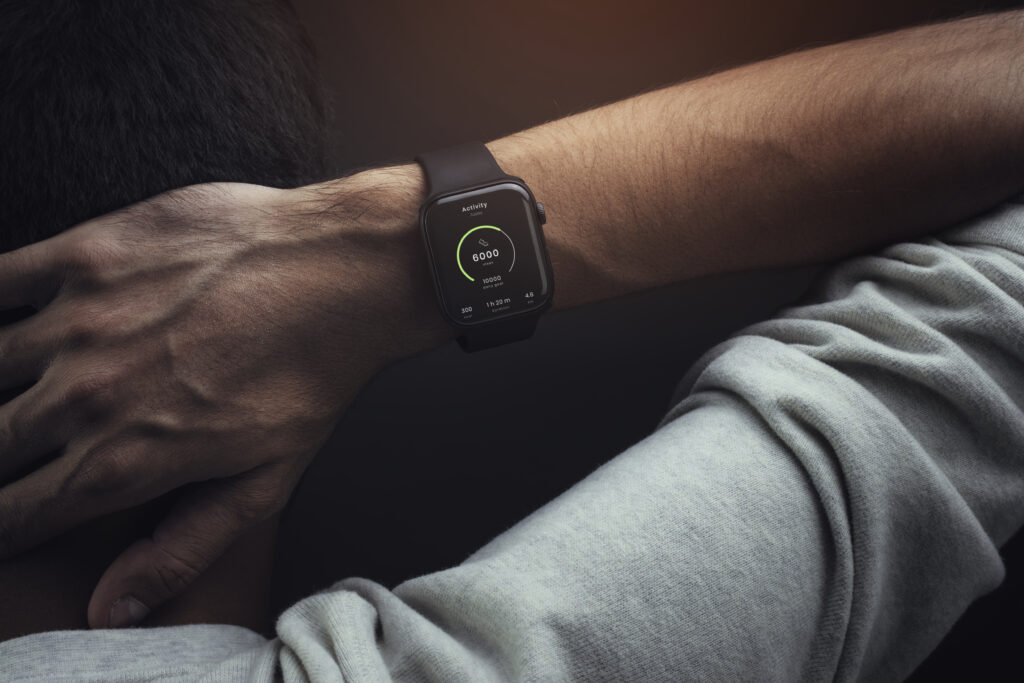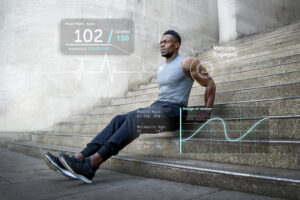
Wearables combined with AI are more than fitness trackers—they’re becoming our personal health guardians, constantly learning from our habits and guiding us to live healthier lives. – Gary Shapiro
Wearable technology refers to smart electronic devices that can be worn on the body as accessories or embedded into clothing. Wearable technology has evolved from basic fitness tracking to advanced health monitoring, transforming the way we interact with our bodies and technology. These devices, which range from smartwatches and fitness trackers to smart clothing and even brainwave-monitoring headsets, have integrated into our daily lives, offering real-time data and personalized insights that improve health, fitness, productivity, and overall well-being.
Health Monitoring with Wearable Tech

a. Heart Rate and Cardiovascular Health
One of the most widespread uses of wearable technology is heart rate monitoring. Devices like the Apple Watch, Fitbit, and Garmin track heart rate continuously throughout the day, allowing users to monitor their cardiovascular health. Some wearables can also detect irregular heartbeats, such as atrial fibrillation (AFib), which can be a precursor to stroke or heart failure. The Apple Watch’s AFib detection feature has saved lives by notifying users of abnormal heart rhythms, prompting them to seek medical attention before serious conditions arise. The feature uses an electrocardiogram (ECG) sensor that takes detailed readings, offering hospital-grade accuracy
b. Sleep Tracking
Quality sleep is crucial for mental and physical health, and wearables are helping users understand their sleep patterns better. Smartwatches and fitness bands can monitor different sleep stages (light, deep, and REM sleep) by analyzing movement and heart rate. Wearable sleep trackers like those from Fitbit or Whoop provide insights into sleep duration, restlessness, and disturbances, helping users adjust their habits to get better rest. Some devices even offer personalized suggestions to improve sleep quality, such as reminders to go to bed earlier or reduce screen time before bed.
c. Glucose Monitoring for Diabetics
Wearable technology is revolutionizing the way people with diabetes manage their blood sugar levels. Continuous glucose monitors (CGMs) like the Dexcom G6 allow users to track their blood sugar in real-time without needing to prick their fingers multiple times a day. These devices send alerts to users and caregivers if blood sugar levels go too high or low, helping manage diabetes more effectively.
Fitness Tracking: Pushing Physical Performance

a. Activity Tracking
Wearables have become synonymous with fitness tracking, enabling users to monitor their daily activity levels. Fitbit, Apple Watch, and other fitness trackers record steps, calories burned, and distance traveled, helping users reach their fitness goals and maintain a healthy lifestyle. Tracking daily activities provides motivation for users to stay active, with many devices setting default goals (like 10,000 steps per day) to encourage physical movement.
b. Advanced Fitness Metrics
In addition to basic activity tracking, advanced wearables provide more detailed metrics, such as VO2 max (which measures cardiovascular fitness) and heart rate variability (HRV), which indicates recovery and stress levels. These tools are invaluable for athletes and fitness enthusiasts aiming to optimize their performance. Devices like Garmin and Whoop Strap offer personalized insights into recovery time and suggest workouts based on how well the body has recovered from previous exercises. This ensures that users avoid overtraining and maximize their performance.
c. Sports-Specific Wearables
Beyond general fitness, there are wearables designed for specific sports. For instance, smart tennis rackets can provide feedback on swing speed and accuracy, while golf gadgets analyze swings and offer tips for improvement. These devices provide in-depth performance analysis, giving athletes the data needed to hone their skills.
Beyond Health and Fitness: The Expanding Reach of Wearable Tech

a. Smart Clothing
Wearable technology isn’t limited to watches and fitness bands. Smart clothing integrates sensors directly into fabrics to monitor a variety of health and fitness metrics without the need for an additional device. Hexoskin smart shirts, for example, can track heart rate, breathing rate, and physical activity, offering athletes and fitness enthusiasts a more integrated solution.
Researchers are developing smart textiles that can monitor a person’s hydration levels, body temperature, and muscle activity in real-time, which could transform fitness training and health management.
b. Brainwave Monitoring
Wearables are now extending into mental health, with devices like Muse, which track brain activity to help users improve their focus and meditation. These wearables provide real-time biofeedback, guiding users through relaxation exercises and mindfulness techniques. With mental health becoming a priority worldwide, wearable devices that monitor brain activity can help reduce stress and anxiety, providing actionable insights for better emotional well-being.
c. Wearables in the Workplace
Companies are adopting wearables to enhance productivity and safety in the workplace. Devices that monitor stress levels, physical activity, or sleep patterns can help employees manage work-related fatigue and improve overall productivity. Wearables could also be used in industrial settings to ensure workers’ safety, alerting them if they’re fatigued or at risk of injury.
Conclusion

Wearable technology has already changed how we approach health, fitness, and daily life. From tracking heart rate and sleep to monitoring brain activity and mental health, these devices are empowering individuals with the data and insights they need to live healthier, more productive lives. As innovation continues, wearables will become even more integrated into our daily routines, pushing beyond fitness into healthcare, workplace productivity, and beyond.
Wearable tech’s evolution is only beginning, and the future promises even more exciting possibilities.
